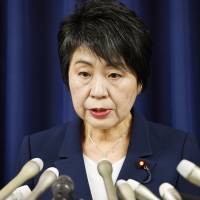Present Justice Minister Yoko Kamikawa
Yoko Kamikawa has ordered 16 executions, the highest among justice ministers since 1993
Kyodo
Jul 26, 2018
- •
Of the 16, 13 were orders for the former cult members. Aum founder Shoko Asahara and six others were hanged earlier this month for their involvement in the 1995 sarin nerve gas attack on the Tokyo subway system and other heinous crimes.
Kamikawa ordered one execution during her former stint as justice minister for a year from October 2014, two in December 2017 and 13 this month, pushing up the number to 16. All of them were under the administration of Prime Minister Shinzo Abe.
Japan had implemented a moratorium on the death penalty between November 1989 and March 1993 due to increasing international pressure to abolish capital punishment. Then-Justice Minister Masaharu Gotoda in the Cabinet of Prime Minister Kiichi Miyazawa resumed the practice of hanging, and since then death row inmates were executed roughly once every six months to a year.
However, Justice Minister Seiken Sugiura, a lawyer-turned-politician, did not give the go-ahead for any executions of death row inmates during his 11 months in office between October 2005 and September 2006 in the Cabinet of Prime Minister Junichiro Koizumi, citing his Buddhist beliefs.
His successor Jinen Nagase took the opposite approach and ordered executions for a total of 10 death row inmates before he stepped down in August 2007. Nagase’s successor Kunio Hatoyama further accelerated hangings by carrying out capital punishments approximately every two months, sending 13 inmates to the gallows by the time he left office in August 2008. The major Asahi Shimbun daily ironically called him the Grim Reaper.
When the Democratic Party of Japan came to power after defeating the Liberal Democratic Party in a 2009 general election, the pace of executions slowed, with a total of nine death row inmates hanged by justice ministers of DPJ administrations that lasted for 39 months to 2012.
Keiko Chiba, the first justice minister under the DPJ government and a lawyer who belonged to an anti-death penalty parliamentarian group before assuming the post, initially took a cautious stance on executions, but eventually ordered hangings of two inmates in July 2010. In an unusual move, she witnessed the executions and allowed the news media to visit the execution chamber at the Tokyo Detention House the following month in a bid to stir public debate over the punishment.
After the LDP came back to power in December 2012, justice ministers ordered executions periodically, with Sadakazu Tanigaki sending 11 inmates to the gallows, Mitsuhide Iwaki four and Katsutoshi Kaneda three.


